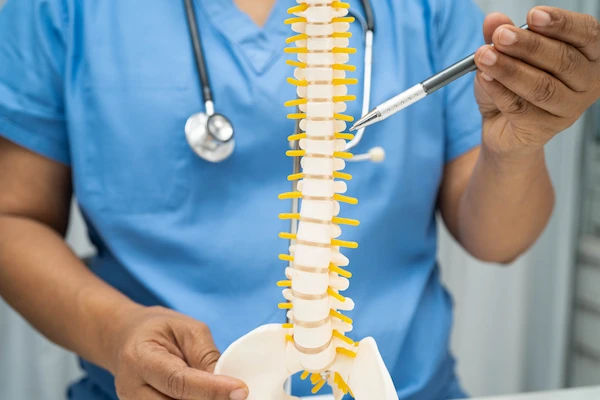Home Tests for Knee Ligament Injury
Know the tests for knee ligament injury, types of injuries, symptoms and home tests for diagnosis of injury. Learn about the prevention and recovery of knee injury and more.

Written by Dr. J T Hema Pratima
Reviewed by Dr. Rohinipriyanka Pondugula MBBS
Last updated on 5th Nov, 2025
.jpeg?tr=q-80,f-webp,w-350,dpr-2,c-at_max 700w)
Introduction
Knee ligament injuries are common, especially among athletes and active individuals. However, anyone can experience a knee ligament injury due to sudden twists, falls, or accidents. If you suspect a ligament injury but aren’t sure, certain home tests can help you assess the severity before seeking medical help.
In this article, we’ll discuss:
What knee ligament injuries?
Common symptoms
Simple home tests you can try
When to see a doctor?
Tips for recovery and prevention
Understanding Knee Ligament Injuries
Your knee has four main ligaments that provide stability:
1. Anterior Cruciate Ligament (ACL) – Prevents the shinbone from sliding forward.
2. Posterior Cruciate Ligament (PCL) – Prevents the shinbone from sliding backwards.
3. Medial Collateral Ligament (MCL) – Stabilises the inner knee.
4. Lateral Collateral Ligament (LCL) – Stabilises the outer knee.
A ligament injury can range from a mild sprain (stretching) to a complete tear, leading to pain, swelling, and instability.
Consult a top orthopaedic for the best advice
Common Symptoms of a Knee Ligament Injury
If you’ve hurt your knee, watch for these signs:
Sharp pain during movement
Swelling within a few hours
Difficulty walking or bearing weight
A popping sound at the time of injury
Feeling of instability (like the knee is giving way)
Simple Home Tests for Knee Ligament Injury
While these tests can give you an idea, they are not a substitute for professional diagnosis. If pain or swelling is severe, consult a doctor immediately.
1. The Lachman Test (For ACL Injury)
How to do it:
Lie on your back with the injured knee slightly bent (about 20-30 degrees).
Hold your thigh steady with one hand and gently pull the shin forward with the other.
What does it mean:
If the shin moves forward excessively, it may indicate an ACL tear.
2. The Anterior Drawer Test (For ACL/PCL Injury)
How to do it:
Sit with your knee bent at 90 degrees.
Place your hands around the upper shin and pull it forward (for ACL) or push it backward (for PCL).
What does it mean:
Excessive movement suggests a possible ligament tear.
3. Valgus Stress Test (For MCL Injury)
How to do it:
Sit with your leg straight.
Place one hand on the outer knee and the other on the ankle.
Gently push inward on the knee while holding the ankle steady.
What does it mean:
Pain or looseness on the inner knee may indicate an MCL sprain or tear.
4. Varus Stress Test (For LCL Injury)
How to do it:
Similar to the MCL test, but push outward on the knee while holding the ankle.
What does it mean:
Pain or looseness on the outer knee suggests an LCL injury.
5. Pivot Shift Test (For Severe ACL Injury)
How to do it:
Lie down and lift your leg slightly.
Rotate your foot inward while bending the knee.
-
What does it mean:
If the knee feels unstable or "shifts," it could be an ACL tear.
When to See a Doctor?
While home tests can help, professional evaluation is crucial if:
Pain is severe and persistent
Swelling doesn’t reduce in 48 hours
You can’t put weight on the knee
The knee feels unstable or locks up
Recovery and Prevention Tips
1. Follow the RICE Method (For Initial Relief)
Rest – Avoid putting weight on the knee.
Ice – Apply ice packs for 15-20 minutes every 2-3 hours.
Compression – Use an elastic bandage to reduce swelling.
Elevation – Keep the knee raised above heart level.
2. Strengthening Exercises (After Pain Subsides)
Straight leg raises
Hamstring stretches
Quad sets (tightening thigh muscles)
3. Wear a Knee Brace (If Needed)
A brace provides extra support during recovery.
4. Avoid High-Impact Activities Initially
Skip running, jumping, or sudden twists until fully healed.
5. Maintain a Healthy Weight
Extra weight puts stress on knee ligaments.
Final Thoughts
Knee ligament injuries can be painful and limit mobility, but early detection helps in faster recovery. While home tests can give clues, consulting a doctor is essential for proper treatment.
Consult a top orthopaedic for the best advice
Consult a top orthopaedic for the best advice

Dr. Anil Pradeep Jadhav
Orthopaedician
23 Years • MBBS MS (Ortho)
Nashik
Apollo Hospitals Nashik, Nashik
(25+ Patients)

Dr. Anoop Bandil
Orthopaedician
16 Years • MBBS, DNB
Delhi
Apollo Hospitals Indraprastha, Delhi

Dr Gandhi Niraj Bharat
Orthopaedician
10 Years • D. Ortho, DNB-Ortho,IGASS, Fellowship London
Chennai
Apollo Hospitals Greams Road, Chennai
(25+ Patients)

Dr. Bhanu Prakash Reddy Rachamallu
Orthopaedician
24 Years • MBBS , D'ORTHO, DNB (ORTHO), Mch (ORTHO), Fellow in ARTHROPLASTY
Hyderabad
Apollo Hospitals Jubilee Hills, Hyderabad
(75+ Patients)

Dr. Rupam Chowdhury
Orthopaedician
10 Years • MBBS, DNB (Ortho.)
Kolkata
MCR SUPER SPECIALITY POLY CLINIC & PATHOLOGY, Kolkata




